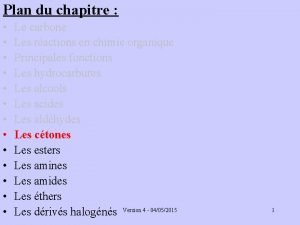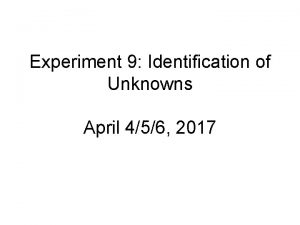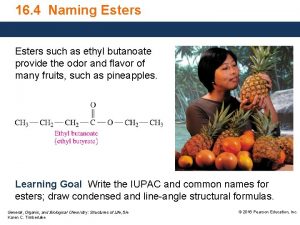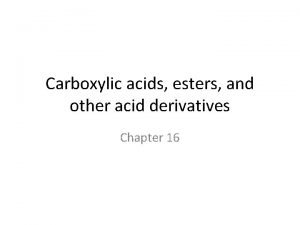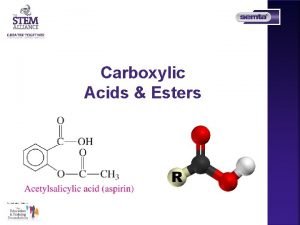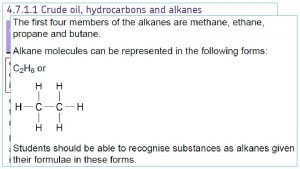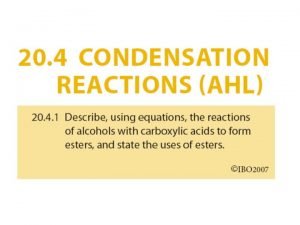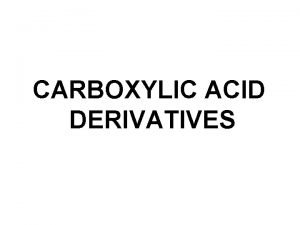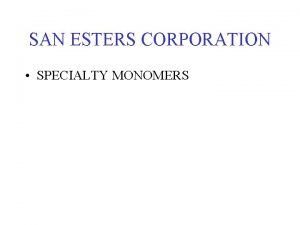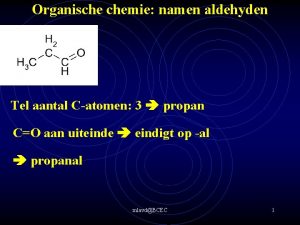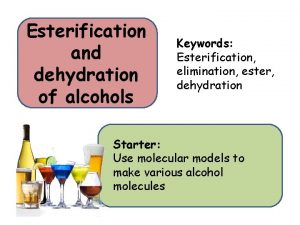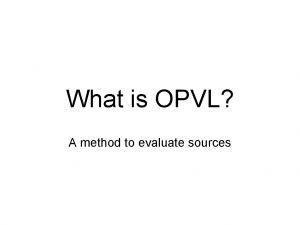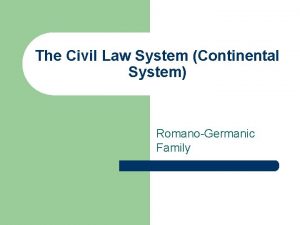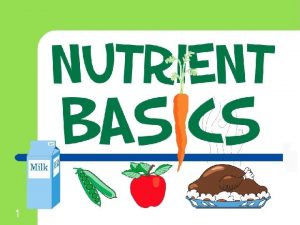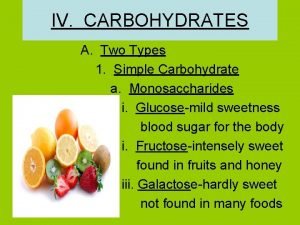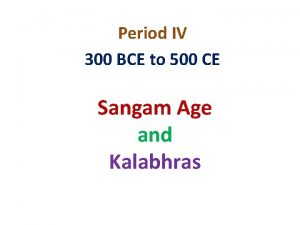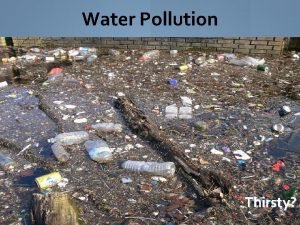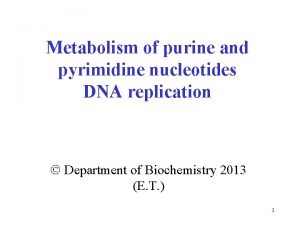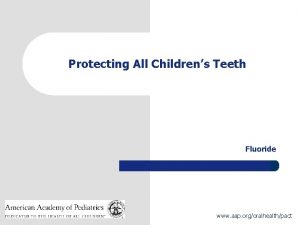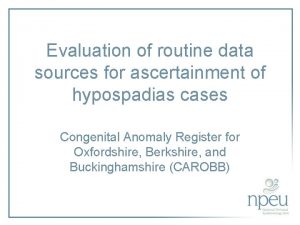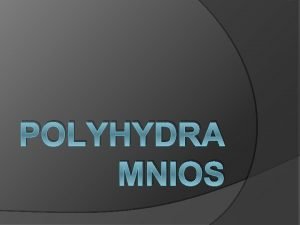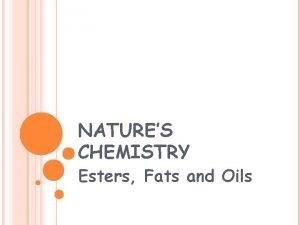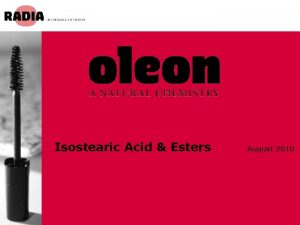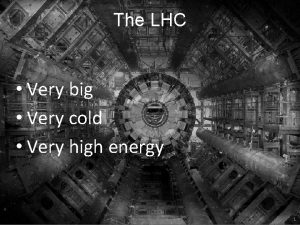20 6 Sources of Esters Esters are very






































































- Slides: 70

20. 6 Sources of Esters

Esters are very common natural products O CH 3 COCH 2 CH(CH 3)2 3 -methylbutyl acetate also called "isopentyl acetate" and "isoamyl acetate" contributes to characteristic odor of bananas

Esters of Glycerol O O CH 2 OCR' RCOCH CH 2 OCR" O R, R', and R" can be the same or different called "triacylglycerols, " "glyceryl triesters, " or "triglycerides" fats and oils are mixtures of glyceryl triesters

Esters of Glycerol O O CH 2 OC(CH 2)16 CH 3(CH 2)16 COCH CH 2 OC(CH 2)16 CH 3 O Tristearin: found in many animal and vegetable fats

Cyclic Esters (Lactones) O O CH 2(CH 2)6 CH 3 H H (Z)-5 -Tetradecen-4 -olide (sex pheromone of female Japanese beetle)

Preparation of Esters Fischer esterification (Sections 15. 8 and 19. 14) from acyl chlorides (Sections 15. 8 and 20. 3) from carboxylic acid anhydrides (Sections 15. 8 and 20. 5) Baeyer-Villiger oxidation of ketones (Section 17. 16)

20. 7 Physical Properties of Esters

Boiling Points CH 3 boiling point CH 3 CHCH 2 CH 3 O 28°C CH 3 COCH 3 57°C OH CH 3 CHCH 2 CH 3 99°C Esters have higher boiling points than alkanes because they are more polar. Esters cannot form hydrogen bonds to other ester molecules, so have lower boiling points than alcohols.

Solubility in Water CH 3 Solubility (g/100 g) CH 3 CHCH 2 CH 3 O ~0 CH 3 COCH 3 33 OH CH 3 CHCH 2 CH 3 12. 5 Esters can form hydrogen bonds to water, so low molecular weight esters have significant solubility in water. Solubility decreases with increasing number of carbons.

20. 8 Reactions of Esters: A Review and a Preview

Reactions of Esters with Grignard reagents (Section 14. 10) reduction with Li. Al. H 4 (Section 15. 3) with ammonia and amines (Sections 20. 13) hydrolysis (Sections 20. 9 and 20. 10)

20. 9 Acid-Catalyzed Ester Hydrolysis

Acid-Catalyzed Ester Hydrolysis is the reverse of Fischer esterification O RCOR' + H 2 O H+ O RCOH + R'OH maximize conversion to ester by removing water maximize ester hydrolysis by having large excess of water equilibrium is closely balanced because carbonyl group of ester and of carboxylic acid are comparably stabilized

Example O CHCOCH 2 CH 3 + H 2 O Cl HCl, heat O CHCOH Cl (80 -82%) + CH 3 CH 2 OH

Mechanism of Acid-Catalyzed Ester Hydrolysis Is the reverse of the mechanism for acidcatalyzed esterification. Like the mechanism of esterification, it involves two stages: 1) formation of tetrahedral intermediate (3 steps) 2) dissociation of tetrahedral intermediate (3 steps)

First stage: formation of tetrahedral intermediate O RCOR' + H 2 O H+ OH RC OH OR' water adds to the carbonyl group of the ester this stage is analogous to the acid-catalyzed addition of water to a ketone

Second stage: cleavage of tetrahedral intermediate O + R'OH RCOH H+ OH RC OH OR'

Mechanism of formation of tetrahedral intermediate



Step 1 • • O H RC + O R' • • +O H RC • • O • • R' carbonyl oxygen is protonated because cation produced is stabilized by electron delocalization (resonance)





Cleavage of tetrahedral intermediate







Key Features of Mechanism Activation of carbonyl group by protonation of carbonyl oxygen Nucleophilic addition of water to carbonyl group forms tetrahedral intermediate Elimination of alcohol from tetrahedral intermediate restores carbonyl group

18 O Labeling Studies O COCH 2 CH 3 + H 2 O H+ Ethyl benzoate, labeled with 18 O at the carbonyl oxygen, was subjected to acidcatalyzed hydrolysis. Ethyl benzoate, recovered before the reaction had gone to completion, had lost its 18 O label. This observation is consistent with a tetrahedral intermediate. O COCH 2 CH 3 + H 2 O

18 O Labeling Studies O COCH 2 CH 3 + H 2 O H+ OH C H+ O COCH 2 CH 3 + H 2 O OH OCH 2 CH 3

20. 10 Ester Hydrolysis in Base: Saponification

Ester Hydrolysis in Aqueous Base O RCOR' O + HO– RCO– + R'OH is called saponification is irreversible, because of strong stabilization of carboxylate ion if carboxylic acid is desired product, saponification is followed by a separate acidification step (simply a p. H adjustment)

Ester Hydrolysis in Aqueous Base O RCOR' O + HO– RCO– + R'OH H+ O RCOH

Example O CH 2 OCCH 3 + Na. OH water-methanol, heat O CH 2 OH (95 -97%) CH 3 + CH 3 CONa

Example O H 2 C CCOCH 3 1. Na. OH, H 2 O, heat 2. H 2 SO 4 O H 2 C (87%) CCOH CH 3 + CH 3 OH

O Soap-Making O CH 2 OC(CH 2)x. CH 3 Basic hydrolysis of the glyceryl CH 3(CH 2)y. COCH triesters (from fats and oils) CH 2 OC(CH 2)z. CH 3 gives salts of long -chain carboxylic O acids. K 2 CO 3, H 2 O, heat These salts are soaps. O CH 3(CH 2)x. COK O CH 3(CH 2)y. COK O CH 3(CH 2)z. COK

Which bond is broken when esters are hydrolyzed in base? • • O • • RCO • • – • • R' + • • OH • • O • • • – RCO • + R'OH • • One possibility is an SN 2 attack by hydroxide on the alkyl group of the ester (alkyl-oxygen cleavage). Carboxylate is the leaving group.

Which bond is broken when esters are hydrolyzed in base? • • O RC – • • OR' + • • OH • • • • O RC – • • OH + • • OR' • • A second possibility is nucleophilic acyl substitution (acyl-oxygen cleavage). • •

18 O Labeling gives the answer O CH 3 CH 2 COCH 2 CH 3 + Na. OH O CH 3 CH 2 CONa 18 O + CH 3 CH 2 OH retained in alcohol, not carboxylate; therefore nucleophilic acyl substitution (acyloxygen cleavage).

Stereochemistry gives the same answer H O CH 3 C KOH, H 2 O alcohol has same configuration at stereogenic center as ester; therefore, nucleophilic acyl substitution (acyloxygen cleavage) C 6 H 5 O C CH 3 O CH 3 COK + HO H C 6 H 5 C CH 3 not SN 2

Does it proceed via a tetrahedral intermediate? • • O RC – • • OR' + • • OH • • • • O RC – • • OH + • • OR' • • Does nucleophilic acyl substitution proceed in a single step, or is a tetrahedral intermediate involved?

18 O Labeling Studies O COCH 2 CH 3 + H 2 O HO– Ethyl benzoate, labeled with 18 O at the carbonyl oxygen, was subjected to hydrolysis in base. Ethyl benzoate, recovered before the reaction had gone to completion, had lost its 18 O label. This observation is consistent with a tetrahedral intermediate. O COCH 2 CH 3 + H 2 O

18 O Labeling Studies O COCH 2 CH 3 + H 2 O HO– OH C HO– O COCH 2 CH 3 + H 2 O OH OCH 2 CH 3

Mechanism of Ester Hydrolysis in Base Involves two stages: 1) formation of tetrahedral intermediate 2) dissociation of tetrahedral intermediate

First stage: formation of tetrahedral intermediate O RCOR' + H 2 O HO– OH RC OH OR' water adds to the carbonyl group of the ester this stage is analogous to the base-catalyzed addition of water to a ketone

Second stage: cleavage of tetrahedral intermediate O + R'OH RCOH HO– OH RC OH OR'

Mechanism of formation of tetrahedral intermediate





Dissociation of tetrahedral intermediate




Key Features of Mechanism Nucleophilic addition of hydroxide ion to carbonyl group in first step Tetrahedral intermediate formed in first stage Hydroxide-induced dissociation of tetrahedral intermediate in second stage

20. 11 Reactions of Esters with Ammonia and Amines

Reactions of Esters O RCOR' O RCNR'2 O RCO–

Reactions of Esters react with ammonia and amines to give amides: O O RCOR' + R'2 NH RCNR'2 + R'OH

Reactions of Esters react with ammonia and amines to give amides: O O RCOR' + R'2 NH RCNR'2 + H via: R O C OR' NR'2 R'OH

Example O H 2 C CCOCH 3 + NH 3 CH 3 H 2 O O H 2 C (75%) CCNH 2 CH 3 + CH 3 OH

Example O FCH 2 COCH 2 CH 3 + NH 2 heat O FCH 2 CNH (61%) + CH 3 CH 2 OH

20. 12 Thioesters

Thioesters are compounds of the type: O RCSR' Thioesters are intermediate in reactivity between anhydrides and esters. Thioester carbonyl group is less stabilized than oxygen analog because C—S bond is longer than C—O bond which reduces overlap of lone pair orbital and C=O p orbital

Thioesters Many biological nucleophilic acyl substitutions involve thioesters. O O RCSR' + Nu H via: RCNu + R'S H R O C SR' Nu H
 Insidan region jh
Insidan region jh Importance of water management
Importance of water management Print and web sources
Print and web sources It is a very shallow skillet with very short sloping sides
It is a very shallow skillet with very short sloping sides Figure 10
Figure 10 Quantifier of food
Quantifier of food Scientific notation rules
Scientific notation rules Few fewfewf
Few fewfewf Ester formation
Ester formation Amide tertiaire
Amide tertiaire Qualitative test for ester
Qualitative test for ester Naming phenols
Naming phenols Ethyl butanoate structure
Ethyl butanoate structure Propylpropanoaat
Propylpropanoaat Iupac naming of esters
Iupac naming of esters Esters naming
Esters naming Is a mixture of hydrocarbons.
Is a mixture of hydrocarbons. Naming of esters
Naming of esters Acyl
Acyl Specialty monomers
Specialty monomers Catomen
Catomen Methanol + propanoic acid
Methanol + propanoic acid Differentiate reliable and unreliable sources;
Differentiate reliable and unreliable sources; عکسme
عکسme Opvl evaluation
Opvl evaluation Two sources of stockholders equity
Two sources of stockholders equity Relevance and reliability of sources
Relevance and reliability of sources Opvl method
Opvl method What is the importance of evaluating the list of references
What is the importance of evaluating the list of references Renewable energy sources are essentially inexhaustible
Renewable energy sources are essentially inexhaustible Discovering american ideals in primary sources
Discovering american ideals in primary sources Sources of civil law
Sources of civil law Sodium food sources
Sodium food sources Fertilizer sources
Fertilizer sources Partial homophones
Partial homophones Primary evidence vs secondary evidence
Primary evidence vs secondary evidence The writer properly quotes and cited sources in some places
The writer properly quotes and cited sources in some places Sources of infection
Sources of infection Continental law
Continental law Apa 7 tutorial
Apa 7 tutorial Sources of international law
Sources of international law Primary source light
Primary source light Nonrenewable energy sources
Nonrenewable energy sources Swept volume
Swept volume Sources of international law
Sources of international law 6 sources of influence
6 sources of influence Syndicated services in marketing research
Syndicated services in marketing research Glycogen sources
Glycogen sources How to not plagiarize
How to not plagiarize Aaseevagam tamil
Aaseevagam tamil Auto power supply control from 4 different sources
Auto power supply control from 4 different sources Examples of point source pollution
Examples of point source pollution Importance of added value
Importance of added value Sources of history images
Sources of history images Five main sources of law
Five main sources of law Tudie
Tudie Measuring sources of brand equity
Measuring sources of brand equity Sources of hypothesis
Sources of hypothesis Site:slidetodoc.com
Site:slidetodoc.com The following sources
The following sources Fluoride natural sources
Fluoride natural sources Primary sources of autobiography
Primary sources of autobiography Les sources du droit de transport
Les sources du droit de transport Routine data sources
Routine data sources Citing evidence sentence starters
Citing evidence sentence starters Sources uk cmatimes
Sources uk cmatimes Sources of amniotic fluid
Sources of amniotic fluid Snr formula
Snr formula Types of graphic sources
Types of graphic sources Main sources of food
Main sources of food Why do businesses need finance
Why do businesses need finance









